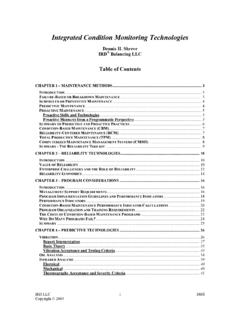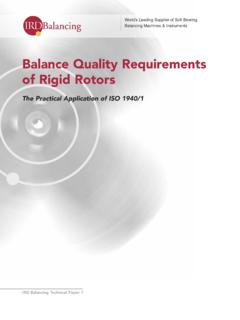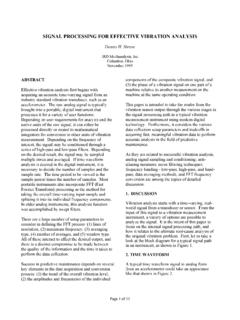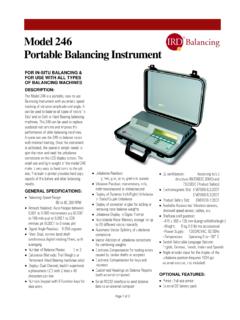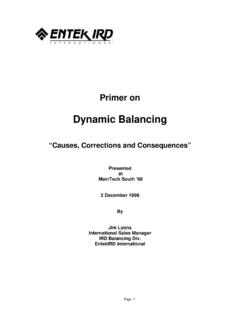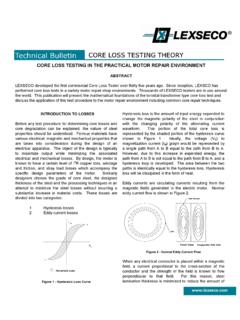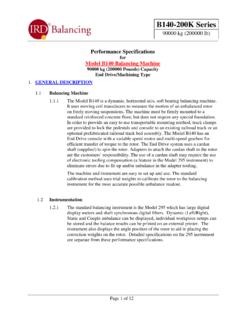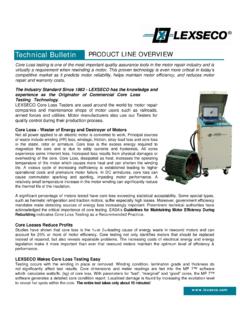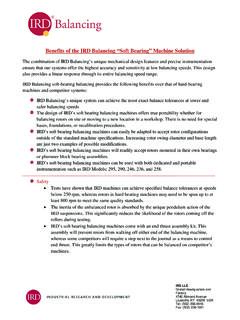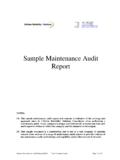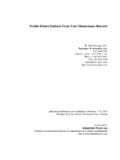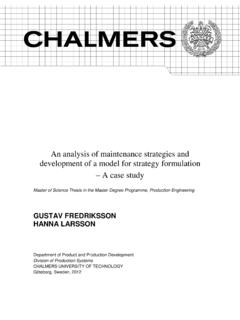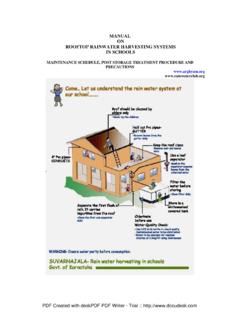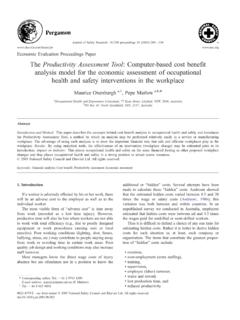Transcription of INTRODUCTION TO VIBRATION TECHNOLOGY - …
1 Page 1 INTRODUCTION TO VIBRATION TECHNOLOGY Dennis H. Shreve Director of Marketing IRD Mechanalysis, Inc. Columbus, Ohio 43229 November 1994 BACKGROUND Machines of some kind are used in nearly every aspect of our daily lives; from the vacuum cleaner and washing machine we use at home, to the industrial machinery used to manufacture nearly every product we use on a daily basis. When a machine fails or breaks down, the consequences can range from annoyance to financial disaster, or personal injury and possible lose of life. For this reason, the early detection, identification and correction of machinery problems is paramount to anyone involved in the maintenance of industrial machinery to insure continued, safe and productive operation. This paper introduces you to the use of machinery VIBRATION and the technological advances that have been developed over the years , making it possible to not only detect when a machine is developing a problem, but to identify the specific nature of the problem for scheduled correction.
2 VIBRATION AS AN INDICATOR OF MACHINERY CONDITION How many times have you touched a machine to see if it was "running right"? With experience, you have developed a "feel" for what is normal and what is abnormal in terms of machinery VIBRATION . Even the most inexperienced driver knows that something is wrong when the steering wheel vibrates or the engine shakes. In other words, it's natural to associate the condition of a machine with its level of VIBRATION . Of course, it's natural for machines to vibrate. Even machines in the best of operating condition will have some VIBRATION because of small, minor defects. Therefore, each machine will have a level of VIBRATION that may be regarded as normal or inherent. However, when machinery VIBRATION increases or becomes excessive, some mechanical trouble is usually the reason.
3 VIBRATION does not increase or become excessive for no reason at all. Something causes it - unbalance, misalignment, worn gears or bearings, looseness, etc. Since not everyone has the long-term experience needed to judge a machine's condition based on how it feels, various instruments have been developed over the years to measure the actual level or amount of VIBRATION . In addition, human perception of touch and feel is somewhat limited, and there are many common problems such as the early stages of bearing and gear failure that are generally out of the range of human perception. Thus, modern instrumentation for measuring VIBRATION on rotating and reciprocating machinery not only minimizes the need for extensive experience, but makes it possible to detect developing problems that are outside the range of human senses of touch and hearing.
4 Further, human perception differs from individual to individual. What one person may consider as bad, another may consider as normal. Attempting to trend changes in machinery condition using human perception is nearly impossible, since it is nearly impossible to put a documented number on "how it feels". To overcome this problem, instrumentation has been developed to actually measure a machine's VIBRATION level and assign it a numerical value. This tool not only overcomes the limitations of inexperience, but it addresses the limitations of human perception as well. page 2 WHAT IS VIBRATION ? VIBRATION can be defined as simply the cyclic or oscillating motion of a machine or machine component from its position of rest. WHAT CAUSES VIBRATION ?
5 Forces generated within the machine cause VIBRATION . These forces may: 1. Change in direction with time, such as the force generated by a rotating unbalance. 2. Change in amplitude or intensity with time, such as the unbalanced magnetic forces generated in an induction motor due to unequal air gap between the motor armature and stator (field). 3. Result in friction between rotating and stationary machine components in much the same way that friction from a rosined bow causes a violin string to vibrate. 4. Cause impacts, such as gear tooth contacts or the impacts generated by the rolling elements of a bearing passing over flaws in the bearing raceways. 5. Cause randomly generated forces such as flow turbulence in fluid-handling devices such as fans, blowers and pumps; or combustion turbulence in gas turbines or boilers.
6 Some of the most common machinery problems that cause VIBRATION include: 1. Misalignment of couplings, bearings and gears 2. Unbalance of rotating components 3. Looseness 4. Deterioration of rolling-element bearings 5. Gear wear 6. Rubbing 7. Aerodynamic/hydraulic problems in fans, blowers and pumps 8. Electrical problems (unbalance magnetic forces) in motors 9. Resonance 10. Eccentricity of rotating components such as "V" belt pulleys or gears VIBRATION AND MACHINE LIFE Your first question may be: "Why worry about a machine's VIBRATION ?" Obviously, once a machine is started and brought into service, it will not run indefinitely. In time, the machine will fail due to the wear and ultimate failure of one or more of its critical components.
7 And, the most common component failure leading to total machine failure is that of the machine bearings, since it is through the bearings that all machine forces are transmitted. Of course, the next question is: "How long will be bearings last?" Although an exact answer to this question is impossible, the manufacturers of rolling element bearings attempt to estimate bearing life using the following calculation: L10 LIFE (HOURS) = (16,666/RPM) X (RATE/LOAD)3 page 3 where: RPM = Machine rotating speed in Revolutions Per Minute RATE = The rated load capacity of the bearing (lbs.) LOAD = The actual load on the bearing. This includes not only the static load due to the weight of the rotor, but the dynamic load due to forces of unbalance, misalignment, etc.
8 , FORCES THAT CAUSE VIBRATION . According to this calculation to estimate bearing life, doubling the rotating speed from, say 1800 RPM to 3600 RPM, would cut bearing life in half. However, by cutting the load on the bearing by one-half would increase its service life by eight times (2-cubed or 2 x 2 x 2 = 8). Of course, this estimate of bearing life does not take into consideration other factors such as inadequate lubrication, lubricant contamination or damage from improper storage or installation techniques. From the above calculation, it can be seen that bearing load, including dynamic load from vibratory sources such as unbalance and misalignment, has a significant effect on bearing life and, ultimately, machine life. Further, the amount of VIBRATION exhibited by a machine is directly proportional to the amount of force generated.
9 In other words, if the unbalance force is doubled, the resultant VIBRATION amplitude will be doubled also. Or, if the unbalance force is cut in half, the unbalance-generated VIBRATION will be cut in half also. Therefore, the answer to the question: "Why worry about a machine's VIBRATION ?" is simple: 1. Increased dynamic forces (loads) reduce machine life. 2. Amplitudes of machinery VIBRATION are directly proportional to the amount of dynamic forces (loads) generated. If you double the force, you double the VIBRATION . 3. Logically then, the lower the amount of generated dynamic forces, the lower the levels of machinery VIBRATION and the longer the machine will perform before failure. It's really that simple. Low levels of VIBRATION indicate low vibratory forces , resulting in improved machine life.
10 Of course, there are other reasons to strive for low levels of machinery VIBRATION besides increasing the time between failures. In the case of precision machine tools, maintaining low levels of VIBRATION is necessary in order to manufacture quality products from a dimensional tolerance and surface finish quality standpoint. In residences, office buildings and hospitals, low levels of VIBRATION of heating, ventilation, air conditioning and other machinery is necessary to avoid human annoyance. With few exceptions, when the condition of a machine deteriorates, one of two (and possibly both) things will generally happen: 1. The dynamic forces generated by the machine will increase in intensity, causing an increase in machine VIBRATION . Wear, corrosion or a build-up of deposits on the rotor may increase unbalance forces.
